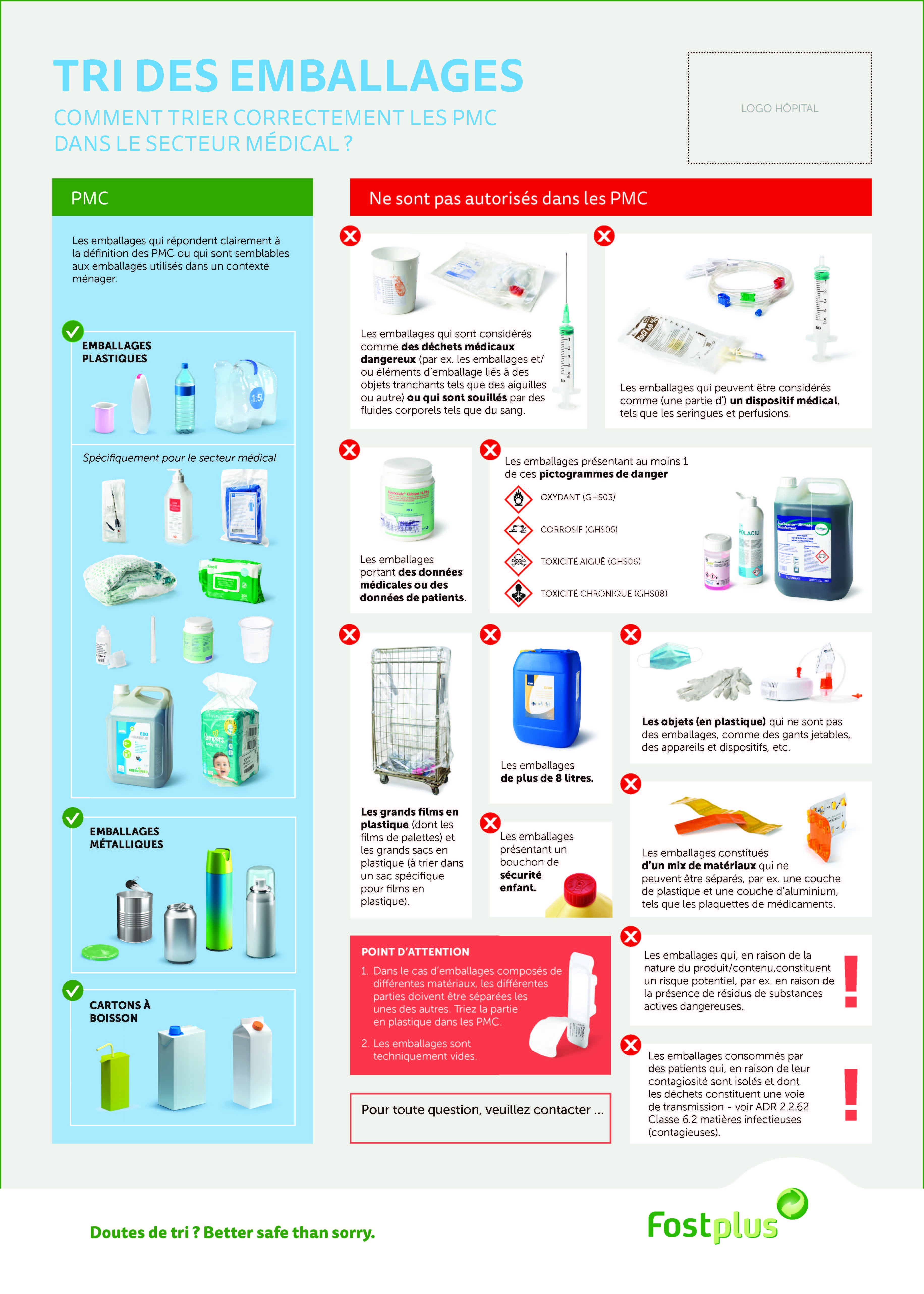Like all companies, hospitals are subject to sorting rules. However, sorting in the medical field is fairly complex as account has to be taken of the medical environment, which is very different from conventional sectors of activity. In fact, it is sometimes difficult to know which packaging should be put with the PMD and which does not belong there. In addition, should it be considered to be household waste or industrial waste? Some members of staff are still uncertain about this.
To overcome these doubts, Fost Plus has worked with various experts to fine-tune, clarify and communicate the sorting rules as clearly as possible.
Stakeholder questions
The spectrum of medical and hospital waste is very broad and is sometimes considered to be a ‘niche’ category. No wonder members of staff had a great many questions about the sorting rules. In fact, even though certain types of waste are very similar to that which may be found in our homes, other packaging is less so. The place where they are used is different as well, which may mean that they should be disposed of in high-risk or no-risk medical waste.
These questions are due to a real willingness on the part of medical staff to sort their waste correctly. So it is important to have coherent communication and provide them with support for this non-standard waste.
The solution
In order to discuss the specific features linked to the medical sector and provide clearer sorting instructions, Fost Plus brought together a panel of experts. It included Valipac, which is responsible for industrial waste, Veolia, representing the waste operators, the medical sector represented by UZ Leuven and ZNA, and finally Ovam, the public waste agency of Flanders. Other partners were consulted where necessary.
At the base of these discussions lay a willingness to come up with a joint and pragmatic solution that could be easily applied in practice, taking account of recycling and safety issues.
Thanks to these discussions, the various stakeholders were able to identify and specify waste that can or cannot be put in the blue PMD bag. To make sure that everyone can be informed, the rules have been set out using different communication tools.
Clear posters displaying the sorting rules are available for different parties. Other documents containing useful tips to improve and/or implement PMD sorting in the organisation have also been drawn up. There is also a memorandum available explaining the ‘context’, the ‘starting points’ and the ‘basic principles’ for the PMD sorting rules in the medical sector. Finally, Fost Plus has sent out advice on how to set up sorting islands properly.
Fost Plus believes that this exercise could benefit other sectors of activity where questions about waste sorting still remain, such as the hospitality industry.
So what are the PMD sorting rules in the medical field exactly?
All conventional PMD packaging is accepted. To this can be added plastic packaging specific to the medical field, such as cream jars, containers, packaging for single-use sterilised instruments, packaging for disposable dressing gowns and packaging for wet wipes or nappies.
However, it is forbidden to throw away hazardous medical waste. For example, the packaging and/or packaging elements used for sharp objects (such as needles, etc.) or those soiled by bodily fluids such as blood.
It is also forbidden to throw away packaging considered to be (part of) a medical device, such as syringes or drips.
Packaging containing medical data or patient data is also forbidden.
As is the case for the sorting rules at home, packaging bearing pictograms indicating hazards or that with childproof safety caps is forbidden. Large packaging items, such as those over 8 litres, large palette wrapping films and big plastic bags are not accepted. This also applies to plastic objects which are not packaging (masks, gloves, etc.) or packaging comprising a mix of inseparable materials, such as that made up of a combination of plastic and aluminium.
Lastly, all packaging that constitutes a potential risk owing to the presence of residual hazardous active substances is banned from the PMD. This also applies to packaging used by patients who are in isolation because they are contagious and whose waste is a means of transmission.
It is also important to point out that the packaging must be empty before it is thrown away.
Finally, we would like to remind you of the principle "better safe than sorry". With this in mind, we always invite our staff to use their common sense to protect the various people who come into contact with the waste stream.
An overview of the rules can be found here:


